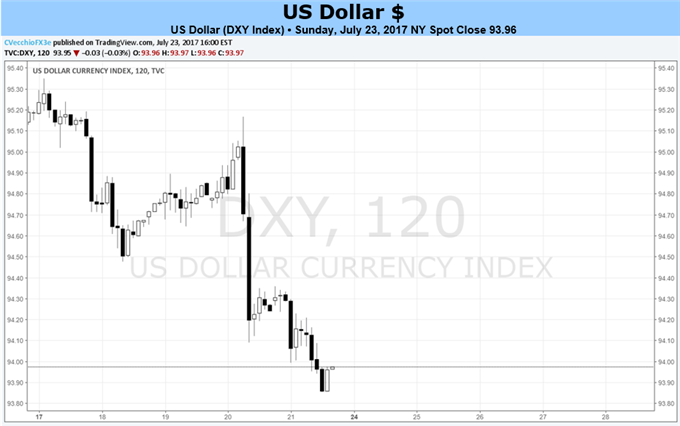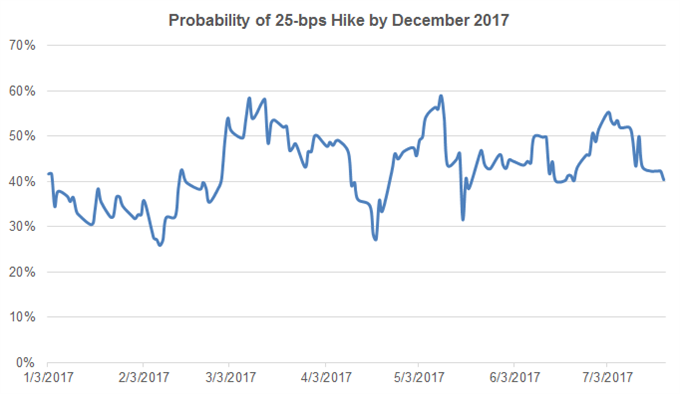
Fundamental Forecast for DXY Index: Neutral
- Coming week is back-loaded with key economic data and events: the FOMC rate decision on Wednesday, the preliminary June Durable Goods report on Thursday, and the initial Q2’17 GDP reading on Friday.
- US Dollar (via DXY Index) is just off of yearly lows as economic data trends have remained downward sloping; it needs a strong week data-wise to stabilize.
- See our Q3’17 EUR/USD forecast as we approach the one-quarter mark for the quarter.
Despite an empty economic docket on both the data and speeches sides, the US Dollar’s sell off found no reprieve last week, as the greenback ended as the second worst performing currency overall. Notable, despite a seemingly dovish European Central Bank President Mario Draghi, EUR/USD gained +1.68% while soaring into two-year highs. Similarly, despite a decidedly dovish Bank of Japan, USD/JPY lost 1.26%. Now, with the US Dollar (via DXY Index) sitting just off of yearly lows, attention turns to the full slate of US economic data and the Federal Reserve policy meeting on Wednesday to see if the greenback can find any stabilizers.
While it is considered a ‘high’ rated event, the July US Consumer Confidence reading on Tuesday is probably the least important ‘high’ rated event on the calendar this week. There has been a longstanding disconnect between sentiment readings and real economic activity, so the data will probably be overlooked if not dismissed by the market. Although US equity markets are near all-time highs, consistent acrimony in Washington D.C. has probably started to erode otherwise stellar confidence readings (which themselves are near their highest levels since 2000).
The week truly begins for the US Dollar on Wednesday, even though the Federal Reserve is not expected to move on rates. After all, it is an ‘off-cycle meeting,’ or one that won’t produce a new summary of economic projections (SEPs) and a press conference with Fed Chair Janet Yellen. Accordingly, the policy statement will garner all of the attention.
Given the steadfast support for a majority of Fed policymakers – particularly 2017 voting members – to raise rates again before the end of the year, it is possible that the Fed uses this ‘off-cycle’ meeting to begin the implementation of their balance sheet normalization strategy, which was outlined at the June meeting in the “Policy Normalization Principles and Plans” augmentation.
The Fed intends to wind down its balance sheet with an initial reinvestment cap for US Treasuries at“$6 billion per month initially, and will increase in steps of $6 billion at three-month intervals over 12-months, until it reaches $30 billion per month.For payments of principal that the Federal Reserve receives from its holdings of agency debt and mortgage-backed securities, the Committee anticipates that the cap will be $4 billion per month initially and will increase in steps of $4 billion at three-month intervals over 12 months until it reaches $20 billion per month.”
Chart 1: DXY Index versus US 5-year, 5-year Inflation Swap Forwards (July 2016 to July 2017)

The headstrong behavior by the Fed to plow ahead and continue with its desired tightening schedule could reawaken rate timing speculation, which has been decidedly dovish after recent weeks of poor economic data. The US Citi Economic Surprise Index closed last week at -52.6, down from -4.8 three-months prior. During this time, inflation expectations have dropped in parallel, with the 5-year, 5-year inflation swap forwards moving from 2.404% on April 28 to 2.207% on July 21.
Chart 2: Probability of Fed Rate Hike by End of 2017

Amid the lackluster US data performance and slump in medium-term US inflation expectations, the odds of a Fed rate hike by the December 2017 meeting have eroded steadily. At the end of last week on July 21, the implied probability of a 25-bps rate hike was 40.4%; three-months earlier, back on April 28, it was 46.7%. The timing of the next hike, per Fed funds futures contracts, has been pointing to March 2018, although in recent days this has started to oscillate to further out on the calendar; late-Q1’18 or early-Q2’18 is now priced-in.
Should the Federal Reserve’s July policy statement reveal the beginning of the normalization process and a reaffirmation of the desire to raise rates by the end of the year, perhaps market participants will be forced to confront the divergence between what the Fed is saying it wants to do and the much more dovish interpretation that the market currently holds. If so, the US Dollar may just finally find a reprieve after its latest swing lower.
At the end of the week, preliminary June US Durable Goods Orders on Thursday will draw interest as usual. Durable Goods represent items with lifespans of three-years or longer (think appliances), so the data tends to be a reliable indicator for underlying consumption trends in the US economy. June US Trade Balance figures will also be released, although they won’t be of great focus given other data being released.
Finally, on Friday, the initial Q2’17 US GDP report will be released, and all eyes are looking for a rebound after a lackluster +1.4% performance in Q1. According to a Bloomberg News survey, the consensus forecast calls for a +2.5% annualized rate of growth from April through June. This matches up exactly with the estimate from the Atlanta Fed’s GDPNow forecast model.
All in all, the coming week is shaping up to be a potentially pivotal one for the US Dollar. Important economic data littered throughout the week enveloping a FOMC rate decision in the middle means volatility for the greenback should be higher. Through the noise, the US Dollar may just yet to be able to find a stabilizing factor to help throw the brakes on its recent slide.
See our Q3’17 US Dollar forecast - check out the DailyFX Trading Guides.
--- Written by Christopher Vecchio, Senior Currency Strategist
To contact Christopher, email him at cvecchio@dailyfx.com
Follow him in the DailyFX Real Time News feed and Twitter at @CVecchioFX.
To receive this analyst’s reports, sign up for his distribution list.




